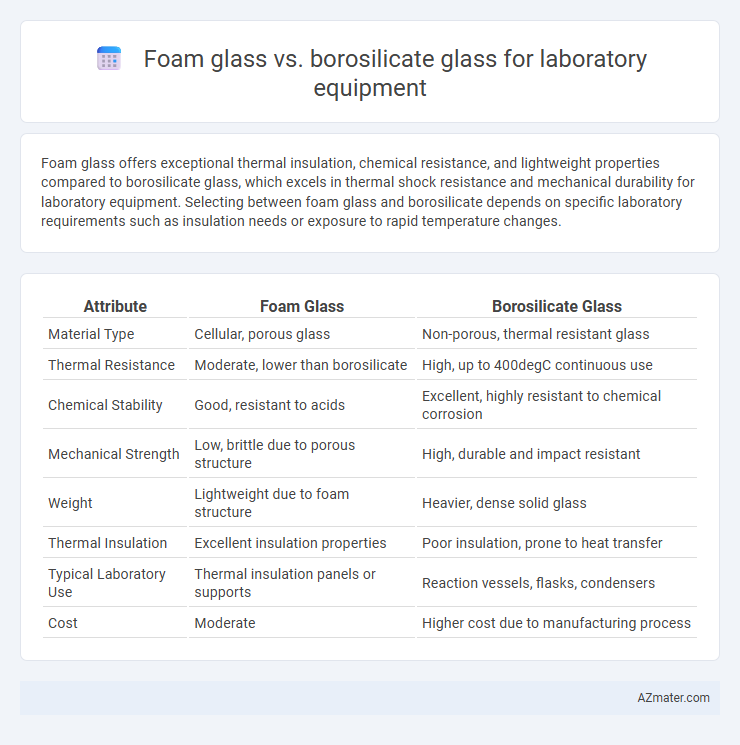Foam glass offers exceptional thermal insulation, chemical resistance, and lightweight properties compared to borosilicate glass, which excels in thermal shock resistance and mechanical durability for laboratory equipment. Selecting between foam glass and borosilicate depends on specific laboratory requirements such as insulation needs or exposure to rapid temperature changes.
Table of Comparison
| Attribute | Foam Glass | Borosilicate Glass |
|---|---|---|
| Material Type | Cellular, porous glass | Non-porous, thermal resistant glass |
| Thermal Resistance | Moderate, lower than borosilicate | High, up to 400degC continuous use |
| Chemical Stability | Good, resistant to acids | Excellent, highly resistant to chemical corrosion |
| Mechanical Strength | Low, brittle due to porous structure | High, durable and impact resistant |
| Weight | Lightweight due to foam structure | Heavier, dense solid glass |
| Thermal Insulation | Excellent insulation properties | Poor insulation, prone to heat transfer |
| Typical Laboratory Use | Thermal insulation panels or supports | Reaction vessels, flasks, condensers |
| Cost | Moderate | Higher cost due to manufacturing process |
Introduction to Laboratory Glass Materials
Foam glass and borosilicate glass serve distinct roles in laboratory equipment due to their differing properties. Borosilicate glass is renowned for its high thermal resistance, chemical durability, and mechanical strength, making it ideal for reaction vessels, beakers, and condensers. Foam glass, characterized by its porous structure and excellent thermal insulation, is primarily utilized for laboratory insulation and protective applications rather than direct chemical processing.
What is Foam Glass?
Foam glass is a cellular, porous material made by heating crushed glass with a foaming agent to create a lightweight, insulating structure commonly used in laboratory equipment for thermal insulation and chemical resistance. Unlike borosilicate glass, which is valued for its high thermal shock resistance and chemical durability, foam glass offers enhanced insulation properties due to its closed-cell structure that traps air. This makes foam glass ideal for applications requiring energy efficiency and structural stability under extreme temperatures without compromising chemical inertness.
What is Borosilicate Glass?
Borosilicate glass, a high-performance glass type composed primarily of silica and boron trioxide, offers exceptional thermal resistance and chemical durability, making it ideal for laboratory equipment exposed to rapid temperature changes. Unlike foam glass, which is lightweight and insulating, borosilicate glass withstands thermal shock and chemical corrosion, ensuring safety and longevity in lab applications such as beakers, flasks, and test tubes. Its low thermal expansion coefficient enhances stability during heating and cooling cycles, crucial for precise scientific experiments.
Thermal Resistance Comparison
Foam glass exhibits excellent thermal insulation properties with low thermal conductivity around 0.04 W/m*K, making it highly resistant to heat transfer and suitable for high-temperature laboratory environments. Borosilicate glass withstands thermal shock and temperatures up to approximately 450degC, offering strong resistance to sudden temperature changes but higher thermal conductivity around 1.1 W/m*K. For laboratory equipment requiring superior insulation and minimal heat loss, foam glass outperforms borosilicate glass, while borosilicate glass remains favored for direct heat exposure and chemical resistance.
Chemical Durability Analysis
Foam glass exhibits high chemical resistance due to its inert silica-based composition and closed-cell structure, making it suitable for applications requiring resistance to acids and alkalis. Borosilicate glass is renowned for its exceptional chemical durability, with excellent resistance to thermal shock and most chemical reagents, attributed to its low alkali content and stable boron oxide framework. Comparative analysis reveals borosilicate glass offers superior chemical resistance under extreme laboratory conditions, while foam glass provides enhanced insulation and structural benefits with moderate chemical stability.
Mechanical Strength and Fragility
Foam glass exhibits lower mechanical strength and higher fragility compared to borosilicate glass, making it less suitable for high-impact laboratory applications. Borosilicate glass offers superior mechanical resistance and thermal shock durability due to its robust chemical composition and structural integrity. This enhanced strength and reduced fragility make borosilicate glass the preferred material for laboratory equipment requiring frequent handling and exposure to temperature variations.
Cost and Availability
Foam glass is generally more cost-effective than borosilicate glass due to its lower manufacturing expenses and widespread availability as an insulating material. Borosilicate glass, known for its exceptional thermal resistance and chemical durability, tends to be more expensive and less readily available in bulk for general laboratory equipment. Laboratories requiring precise chemical resistance and heat tolerance often invest in borosilicate glass despite higher costs, whereas foam glass is preferred for budget-conscious insulation applications.
Suitability for Laboratory Applications
Foam glass offers excellent thermal insulation and chemical resistance, making it suitable for applications requiring lightweight, non-reactive materials, but its porous structure limits its use in precision laboratory glassware. Borosilicate glass is preferred for laboratory equipment due to its superior thermal shock resistance, high chemical durability, and ability to withstand extreme temperature changes without cracking. The choice between foam glass and borosilicate glass largely depends on the specific lab application, with borosilicate glass dominating in tasks requiring clarity, strength, and precise chemical interactions.
Environmental Impact and Recyclability
Foam glass exhibits superior environmental benefits due to its production from recycled glass and excellent thermal insulation properties, reducing energy consumption during laboratory processes. Borosilicate glass, while durable and resistant to thermal shock, typically requires higher energy for manufacturing and has limited recyclability compared to foam glass. The recyclability of foam glass contributes to lower landfill waste, positioning it as a more sustainable choice for eco-conscious laboratory environments.
Conclusion: Choosing the Right Glass for Your Laboratory
Foam glass offers excellent thermal insulation and chemical resistance, making it ideal for applications requiring lightweight and durable materials. Borosilicate glass excels in thermal shock resistance and high-temperature stability, crucial for precise laboratory heating and chemical reactions. Selecting the right glass depends on the specific laboratory needs: foam glass suits insulation and structural support, while borosilicate glass is preferred for direct contact with chemicals and heat-intensive processes.

Infographic: Foam glass vs Borosilicate glass for Laboratory equipment
 azmater.com
azmater.com